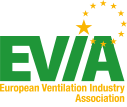EVIA position paper on the implementation of the Energy Efficiency First Principle
10/03/2021

EVIA welcomes the opportunity to contribute to the development of the European Commission’s guidelines on the implementation of the Energy Efficiency First (EE1) principle.
In this submission EVIA, as the association representing manufacturers of ventilation units/systems, considers the implementation of EE1 from the perspective of energy used by Technical Building Systems (TBS) in the built environment. As such the following responds primarily to section ‘3.4. Buildings’ in the discussion document ‘Implementation of the EE1st principle in specific policy areas’.
EVIA note that energy efficiency is a factor that is not mutually exclusive. Indeed, efforts to address energy efficiency often have direct impacts on other factors. These impacts are not always necessarily positively correlated and thus contribute to negative trade-offs in the built environment. EVIA therefore, strongly encourages the Commission to integrate the concept of ‘do no significant harm’ in the forthcoming guidelines on the EE1 principle.
The precautionary principle of ‘do no significant harm’ is already used elsewhere in the EU acquis as a guiding principle for conditionality for private financing. Under the Sustainable Finance Taxonomy Regulation (EU) 2020/2088 financial undertakings are required to ensure that an investment ‘does no significant harm’ to environmental or social objectives, for the investment to be classified as sustainable, bases on harmonised EU criteria for environmentally sustainable activities. In essence, for an investment to be classified as sustainable it should ‘do no significant harm’ to one of the six environmental objectives established under Article 9 Environmental objectives, including non-exhaustively climate change mitigation, and pollution prevention and control.
The ‘do no significant harm’ principle has more recently been utilised as a guiding conditionality for the Recovery and Resilience Facility Regulation, for the dispersal of EU public financing in the context of COVID-19 economic stimulus, including for building renovation initiatives.
In the context of the implementation of EE1, EVIA note the following potentially negative trade-offs, that would be addressed by a ‘do no significant harm’ principle:
- EE1 and Indoor Air Quality
- EE1 and Renovations
The EE1 principle would positively drive the uptake of the latest state-of-the-art energy efficient ventilation units/systems in new and renovations buildings. Public and private financing conditionality, as well as green public procurement criteria are policies that can be used to this effect. However, the assessments should always integrate consideration of the ‘do no significant harm’ principle to avoid unintended negative impacts.

